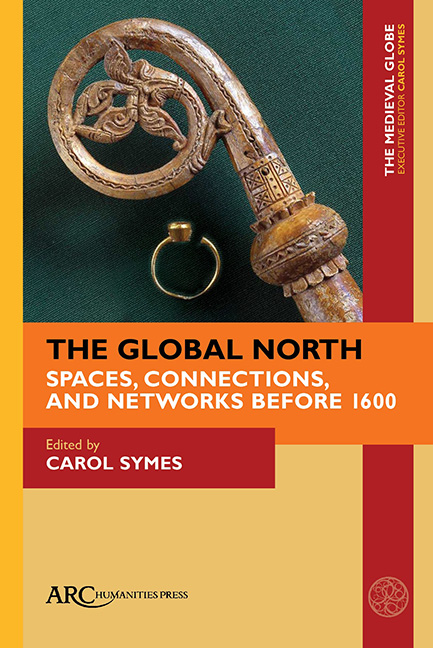Book contents
- Frontmatter
- Contents
- List Of Illustrations
- Introduction: Exploring the Global North, from the Iron Age to the Age of Sail
- Contesting Marginality: The Boreal Forest of Middle Scandinavia and the Worlds Outside
- Archaeological Evidence for Staraya Lagoda as an Early Scandinavian Emporium of the Global North
- Gunhild’s Cross and the North Atlantic Trade Sphere
- The Far North in the Eyes of Adam of Bremen and the Anonymous Author of the Historia Norwegie
- The Multi-Layered Spatiality of the Global North: Spatial References and Spatial Constructions in Medieval East Norse Literature
- Military Migration in the Baltic Sea Region, ca. 1400–1620
- Old and New Land in the North and West: The North Atlantic on the Medieval Globe around 1500
- Index
Old and New Land in the North and West: The North Atlantic on the Medieval Globe around 1500
Published online by Cambridge University Press: 20 January 2022
- Frontmatter
- Contents
- List Of Illustrations
- Introduction: Exploring the Global North, from the Iron Age to the Age of Sail
- Contesting Marginality: The Boreal Forest of Middle Scandinavia and the Worlds Outside
- Archaeological Evidence for Staraya Lagoda as an Early Scandinavian Emporium of the Global North
- Gunhild’s Cross and the North Atlantic Trade Sphere
- The Far North in the Eyes of Adam of Bremen and the Anonymous Author of the Historia Norwegie
- The Multi-Layered Spatiality of the Global North: Spatial References and Spatial Constructions in Medieval East Norse Literature
- Military Migration in the Baltic Sea Region, ca. 1400–1620
- Old and New Land in the North and West: The North Atlantic on the Medieval Globe around 1500
- Index
Summary
There are various opinions regarding the circumference of the Earth but it is not possible to verify them. It is said that it is 22,500 or 24,000 miles, more or less, according to the different estimates and opinions, which are not very reliable because they have not been verified by experience (per non esser experimentada). And even if some have repeatedly sailed in the southern and northern regions they have not had time to measure, or even estimate, the distances, given that they navigated as events dictated and not to measure the navigation itself. So I leave to the eternal God the measurement of His work which only He can understand in full.
With this statement, inscribed on his huge (1.96 m diameter) mid-fifteenth-century world map, the famous Venetian mapmaker Fra Mauro accepts that he cannot measure the earth based on the experience available to him. Although he acknowledges that a great deal of experience had already been accumulated by practical navigation to both the southern and northern reaches of the globe, all of this has not, in his view, provided enough information to compass its entirety. Consequently, Fra Mauro constructs a quite traditional circular mappa mundi (medieval world map) which is by far the richest we have, and absolutely up-to-date in terms of content. For us, Fra Mauro's creation represents the challenges of mapping the new knowledge available to Latin Europeans around 1500 and, at the same time, their awareness that they did not know enough.
What could people like Fra Mauro actually know about the North, more specifically about the North Atlantic—and what are we, today, not supposed to expect them to have known? In this article, I will pursue the Latin Europeans’ perspective on new geographical information available to them in the decades around 1500. Taking the “global” in “the Global North” literally, I specifically examine contemporary knowledge about the Northern Atlantic between Europe and whatever lay on the other side, as derived from Scandinavian sources and into the older schools of Latin European mapmaking.
This is a big topic and it will become even bigger through the perspective I employ and explain below.
- Type
- Chapter
- Information
- The Global NorthSpaces, Connections, and Networks before 1600, pp. 131 - 152Publisher: Amsterdam University PressPrint publication year: 2021

